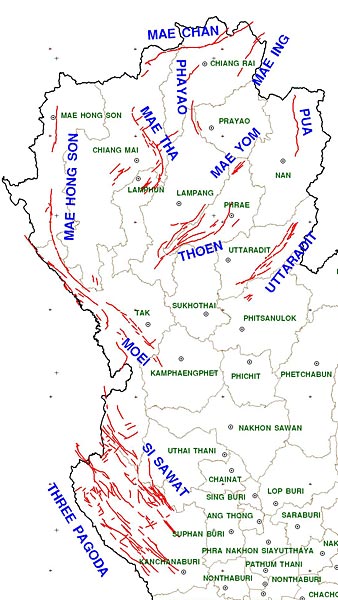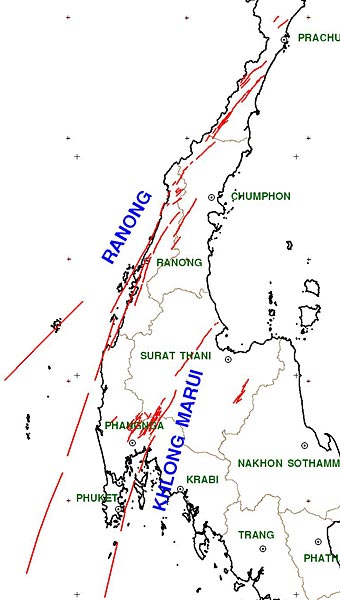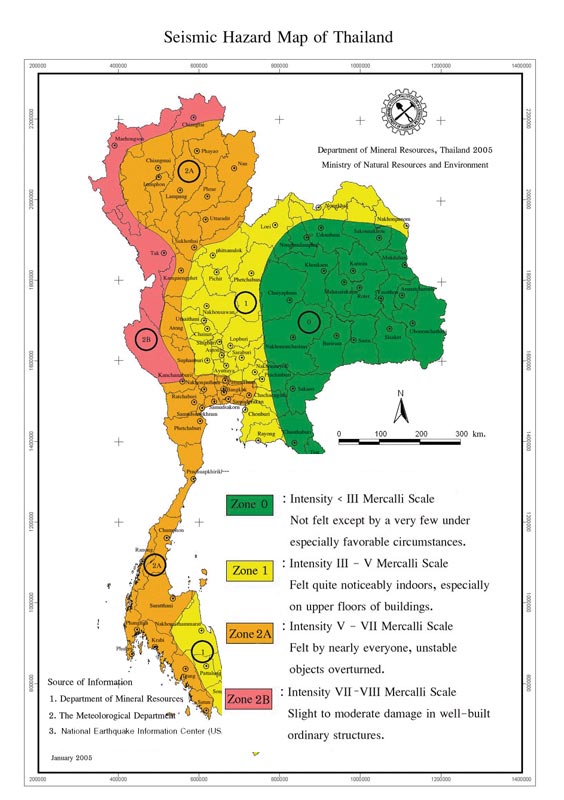Bangkok's Doomsday Scenarios : Floods and Earthquakes
See 'classic' movie of the floods of 1942 at bottom of this page.
Update 2016 also at bottom of page.
By coincidence, in the same week, Bangkok was featured in two different news media. One article in the Bangkok Post stated that Bangkok was at risk if earth quakes occurred several hundred kilometers away from the city. CNN and other Media on the other hand, reported that Bangkok was at risk from rising sea levels, and sinking land levels.
Add-On : See this entertaining video about why the 2011 floods in Thailand came about.
Earth Quakes
A few years back way after midnight, we were walking round in our apartment, when we got the distinct impression that the whole building was swaying for 15 seconds or so. Honestly, we did not think too much of it. The next day it appeared that an earth quake had occurred many hundreds of kilometers away in Myanmar, with some minor damage to buildings in Bangkok (some cracks in the walls at well known locations). Some of the Japanese in our building had come down during the night in some minor panick. They seemed to have judged correctly what was going on.
A seminar on earthquake-resistant buildings was held in Bangkok at the end of October 2007. Apparently 12 provinces in Thailand were added to a 'quake-risk area'. They include Bangkok, some provinces in the central plains and the south of Thailand. At the time, some provinces in the north of the country, were already on the list because of their proximity to active fault lines (including Chiang Mai).
Apparently at present, owners of tall and public buildings, including entertainment venues, warehouses, and hospitals in risk areas are required to design and use materials that can withstand earthquakes. This may add up to 10% to the costs of new buildings. This also means that most buildings in Bangkok at present most likely are at some risks from earthquakes. Bangkok is at risk from two fault lines, one located in Myanmar about 400 km away, one located in Kanchanaburi province about 200 km away.
A lot of buildings in Bangkok seem to be located on 'soft clay'. They could be damaged when an important earthquake occurs at the fault lines. A comparison was made with Mexico City (also on soft clay) that suffered damage from an earthquake 400 km away in 1985. More than 9,000 people were killed and more than 400 buildings destroyed in Mexico at the time.
[based on report in the Bangkok Post, end 2007]
[Update and Add-On : On 24 March 2011 around 9 P.M. Bangkok time, there was an earth quake in eastern Myanmar, about 55 miles (89 km) north of Chiang Rai, Thailand. Initial reports measured a magnitude of 6.8 on the Richter scale, and the quake was relatively shallow. I could feel it distinctly in my apartment of the 12th floor in Bangkok. Actually, I thought I was feeling dizzy, but later realized the 'disturbance' was due to an earth quake. A casualty was reported in Chiang Rai, and there were also casualties in Yunnan province, China. Initial reports mention up to 75 deaths in Burma]
See maps of fault lines and seismic hazard at bottom of page.
Sinking Land and Rising Sea Levels
The Bangkok Metropolis rests at an altitude of 1-2 meters above sea level with some parts of the city already below sea level. Because of its location on soft clay, the city apparently is sinking at a rate of about 4 inches per year. Bangkok was founded 225 years ago on a swampy floodplain along the Chao Phraya River. Beginning in the 1950's a lot of its canals were filled to make way for roads, impairing the natural drainage system. It is conceived that within 15-20 years the whole area may be located below sea level. It is not quite an option to move the whole city away from its present location, so a lot of effort will have to be made protecting Bangkok from being submerged by the sea. Options are : high dikes on both banks of the Chao Phraya River, forking to the right and left at the mouth of the river ; diversion water channels ; more upcountry located dams ; diverting water into reservoirs (the Monkey Cheeks, an idea of Thailand's King).
Besides the sinking of the city, one has to take also into account the possibility of rising sea levels due to global warming. At present this is a slow process, with the waters in the Gulf of Thailand rising at a rate of 1/10 inch each year.
( see this old original report by MSNBC )
In any case, this is something more to think about when you consider buying property in Bangkok.
Update 2016 :
In May 2016 Christian Aid U.K. published an interesting and alarming report entitled : "Act now or Pay later : Protecting a billion people in climate-threatened coastal cities". Christian Aid aims to fight poverty and in this report it lists the major coastal cities most at risk from rising sea levels and associated events (tidal flooding, surface flooding etc.). Thailand in 2010 had 16.4 million people living in low-lying coastal zones. This will increase to 24.7 million in 2030 and 36.8 million people in 2060. [Sea levels may have risen between 0.5 and 1 meter by then]. Bangkok has a population exposed to coastal flooding of 907,000 in 2010, increasing to 5,138,000 in 2070. Only 6 other cities (all in Asia) have more people exposed in 2070. A lot of financial (property) assets are at risk. Assets exposed in 2010 added up to 38.72 billion U.S. Dollar, which may rise to a staggering 1,117.54 billion U.S. Dollar by 2070. [FYI Miami in the U.S. has the most assets exposed in 2070 : 3,5 trillion U.S. Dollar]
PDF-file Report by Christian Aid (we found it on the BBC website) : Christian Aid
Please be advised to this are predictions and economic predictions often seriously miss their mark. Anyway, it is something to think about. At present, there are plans developed to build a kilometers long promenade along the Chao Phraya river. Hopefully, it will be built high enough.
The movie below is quite interesting. It dates from 1942. Apparently at that time a lot of Bangkokians had a boat ready to go in their backyards. While the commentary is in Thai, old hands can easily recognize the locations depicted.

Faultlines in Northern and Central Thailand

Faultlines in Southern Thailand

Maps courtesy of Department of Mineral Resources, Ministry of Natural Resources and Environment, Thailand

